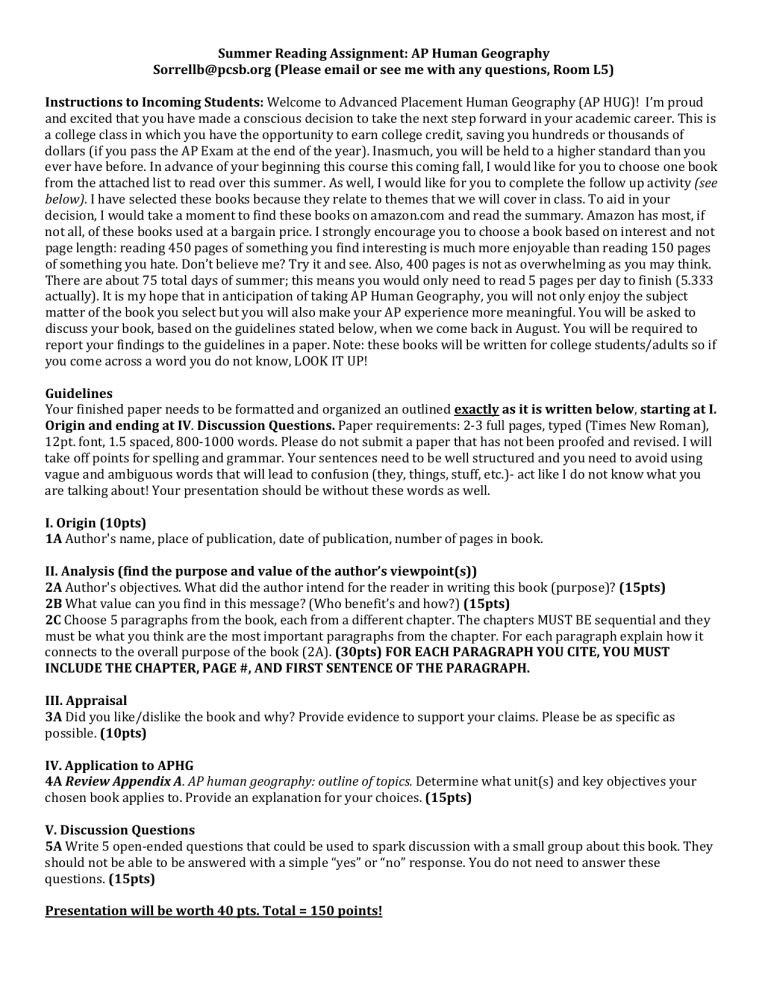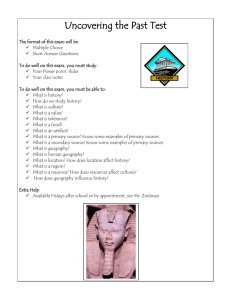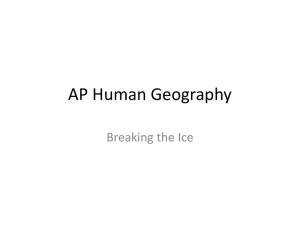AP HUG Summer Reading Assignment

Summer Reading Assignment: AP Human Geography
Sorrellb@pcsb.org (Please email or see me with any questions, Room L5)
Instructions to Incoming Students: Welcome to Advanced Placement Human Geography (AP HUG)! I’m proud and excited that you have made a conscious decision to take the next step forward in your academic career. This is a college class in which you have the opportunity to earn college credit, saving you hundreds or thousands of dollars (if you pass the AP Exam at the end of the year). Inasmuch, you will be held to a higher standard than you ever have before. In advance of your beginning this course this coming fall, I would like for you to choose one book from the attached list to read over this summer. As well, I would like for you to complete the follow up activity (see below) . I have selected these books because they relate to themes that we will cover in class. To aid in your decision, I would take a moment to find these books on amazon.com and read the summary. Amazon has most, if not all, of these books used at a bargain price. I strongly encourage you to choose a book based on interest and not page length: reading 450 pages of something you find interesting is much more enjoyable than reading 150 pages of something you hate. Don’t believe me? Try it and see. Also, 400 pages is not as overwhelming as you may think.
There are about 75 total days of summer; this means you would only need to read 5 pages per day to finish (5.333 actually). It is my hope that in anticipation of taking AP Human Geography, you will not only enjoy the subject matter of the book you select but you will also make your AP experience more meaningful. You will be asked to discuss your book, based on the guidelines stated below, when we come back in August. You will be required to report your findings to the guidelines in a paper. Note: these books will be written for college students/adults so if you come across a word you do not know, LOOK IT UP!
Guidelines
Your finished paper needs to be formatted and organized an outlined exactly as it is written below , starting at I.
Origin and ending at IV . Discussion Questions. Paper requirements: 2-3 full pages, typed (Times New Roman),
12pt. font, 1.5 spaced, 800-1000 words. Please do not submit a paper that has not been proofed and revised. I will take off points for spelling and grammar. Your sentences need to be well structured and you need to avoid using vague and ambiguous words that will lead to confusion (they, things, stuff, etc.)- act like I do not know what you are talking about!
Your presentation should be without these words as well.
I. Origin (10pts)
1A Author's name, place of publication, date of publication, number of pages in book.
II. Analysis (find the purpose and value of the author’s viewpoint(s))
2A Author's objectives. What did the author intend for the reader in writing this book (purpose)? (15pts)
2B What value can you find in this message? (Who benefit’s and how?) (15pts)
2C Choose 5 paragraphs from the book, each from a different chapter. The chapters MUST BE sequential and they must be what you think are the most important paragraphs from the chapter. For each paragraph explain how it connects to the overall purpose of the book (2A). (30pts) FOR EACH PARAGRAPH YOU CITE, YOU MUST
INCLUDE THE CHAPTER, PAGE #, AND FIRST SENTENCE OF THE PARAGRAPH.
III. Appraisal
3A Did you like/dislike the book and why? Provide evidence to support your claims. Please be as specific as possible. (10pts)
IV. Application to APHG
4A Review Appendix A . AP human geography: outline of topics. Determine what unit(s) and key objectives your chosen book applies to. Provide an explanation for your choices. (15pts)
V. Discussion Questions
5A Write 5 open-ended questions that could be used to spark discussion with a small group about this book. They should not be able to be answered with a simple “yes” or “no” response. You do not need to answer these questions. (15pts)
Presentation will be worth 40 pts. Total = 150 points!
Human Geography Reading List (you must choose ONE book from the list below).
1. Why Geography Matters: Three Challenges Facing America: Climate Change, The Rise of China, and
Global Terrorism - Harm de Blij
2. The Power of Place- Harm De Blij
3. Fair Trade for All – Joseph E. Stiglit and Andrew Charlton
4. The Bottom Billion: Why the Poorest countries are Failing and What Can Be Done About It - Paul Collier
5. Persepolis : The Story of a Childhood- Marjane Satrapi (graphic novel)
6. Fast Food Nation: The Dark Side of the All-American Meal – Eric Schlosser
7. Omnivore's Dilemma: A Natural History of Four Meals - Michael Pollan
8. A History of the World in Six Glasses – Tom Standage
9. The Geography of Nowhere: The Rise and Decline of America's Man-Made Landscape - James Howard
Kunstler
10. How Soccer Explains the World: An Unlikely Theory of Globalization - Franklin Foer
11. Reading Lolita in Tehran: Azar Nafisi
12. Cool It: The Skeptical Environmentalist's Guide to Global Warming: Bjorn Lomborg
13. We Just Want to Live Here: An Unlikely Teenage Friendship in the Two Jersusalems - Amal Rifa'I and
Odelia Ainbinder
14. The New Geography of Jobs – Enrico Moretti
15. The Wayfinders: Why Ancient Wisdom Matte rs in the Modern World - Wade Davis
16. Half the Sky: Turning Oppression Into Opportunity for Women Worldwide - Nicholas D. Kristof and Sheryl
WuDunn
17. 10 Geographic Ideas That Changed the World- Susan Hanse
18. The Future of Power - Joseph Nye
19. How to Run the World - Parag Khanna
20. Disposable People: New Slavery in the Global Economy – Kevin Bales
21. Who Hates Whom: Well-Armed Fanatics, Intractable Conflicts, and Various Things Blowing Up— A
Woefully Incomplete Guide – Bob Harris
22. Planet of Slums – Mike Davis
23. The Post-American World - Fareed Zakaria
24. Black Dog of Fate – Perter Balakian
25. Suburban Nation: The Rise of Sprawl and the Decline of the American Dream - Andres Duany
Map Labeling (80pts): Go to the following site, http://www.worldatlas.com/webimage/testmaps/maps.htm and print out these 8 maps: Africa, Asia, Caribbean, Europe, Latin America, North America, Oceania, USA (50 States).
Your job is to label each country and, when appropriate, major oceans, seas, deserts and mountains (disregard rivers and lakes for now). You will have map tests on these countries throughout the year. These maps are due with your paper on the first day of school.
A key advantage for you in this course will be your ability to broaden your “worldview”. I recommend you take a moment each week to familiarize yourself with events that shape our world. There will be many discussions in class based on putting the principles that we learn into practice. The broader and deeper your “world vision,” the more you bring to these discussions.
Appendix A: APHG Outline of Topics
Following is an outline of the major content areas covered by the AP Examination in Human Geography, as well as the approximate percentages of the multiple-choice section that are devoted to each area.
This outline is a guide and is not intended as an exclusive list of topics.
I. Geography: Its Nature and Perspectives (5-
10%)
A. Geography as a field of inquiry
B. Evolution of key geographical concepts and models associated with notable geographers
C. Key concepts underlying the geographical perspective: location, space, place, scale, pattern, regionalization, and globalization
D. Key geographical skills
1. How to use and think about maps and spatial data
2. How to understand and interpret the implications of associations among phenomena in places
3. How to recognize and interpret at different scales the relationships among patterns and processes
4. How to define regions and evaluate the regionalization process
5. How to characterize and analyze changing interconnections among places
6. New geographic technologies, such as GIS and GPS
7. Sources of geographical ideas and data: the field, census data
II. Population (13-17%)
A. Geographical analysis of population
1. Density, distribution, and scale
2. Consequences of various densities and distributions
3. Patterns of composition: age, sex, race, and ethnicity
4. Population and natural hazards: past, present, and future
5. Population growth and decline over time and space
B. Historical trends and projections for the future
1. Theories of population growth, including the Demographic Model
2. Patterns of fertility, mortality, and health
3. Regional variations of demographic transitions
4. Effects of population policies
5. Population movement
C. Push and pull factors
1. Major voluntary and involuntary migrations at different scales
2. Migration selectivity
III. Cultural Patterns and Processes (13-17%)
A. Concepts of culture
1. Traits
2. Diffusion
3. Acculturation
4. Cultural regions
B. Cultural differences
1. Language
2. Religion
3. Ethnicity
4. Gender
5. Popular and folk culture
C. Environmental impact of cultural attitudes and practices
D. Cultural landscapes and cultural identity
1. Values and preferences
2. Symbolic landscapes and sense of place
IV. Political Organization of Space (13-17%)
A. Territorial dimensions of politics
1. The concept of territoriality
2. The nature and meaning of boundaries
3. Influences of boundaries on identity, interaction, and exchange
B. Evolution of the contemporary political pattern
1. The nation-state concept
2. Colonialism and imperialism
3. Federal and unitary states
C. Challenges to inherited political-territorial arrangements
1. Changing nature of sovereignty
2. Fragmentation, unification, alliance
3. Spatial relationships between political patterns and patterns of ethnicity, economy, and environment
4. Electoral geography, including gerrymandering
V. Agricultural and Rural Land Use (13-17%)
A. Development and diffusion of agriculture
1. Neolithic Agricultural Revolution
2. Second Agricultural Revolution
B. Major agricultural production regions
1. Agricultural systems associated with major bio-climatic zones
2. Variations within major zones and effects of markets
3. Linkages and flows among regions of food production and consumption
C. Rural land use and settlement patterns
1. Models of land use, including von Thünen's model
2. Settlement patterns associated with major agriculture types
D. Modern commercial agriculture: the Third
Agricultural Revolution
1. Green Revolution and the beginning of the biotechnologic revolution
2. Characteristics of the third revolution: blending of primary, secondary, and tertiary activities, intensification of mechanization, and development of biotechnology
3. Spatial organization of industrial agriculture
4. Diffusion of industrial agriculture
5. Future food supplies and environmental impacts of agriculture - hopes and fears
VI. Industrialization and Economic Development
(13-17%)
A. Key concepts in industrialization and development
B. Growth and diffusion of industrialization
1. The changing roles of energy and technology
2. Industrial Revolution
3. Evolution of economic cores and peripheries
4. Geographic critiques of models of economic localization (i.e., land rent, comparative costs of transportation), industrial location, economic development, and world systems
C. Contemporary patterns and impacts of industrialization and development
1. Spatial organization of the world economy
2. Variations in levels of development
3. Deindustrialization and economic restructuring
4. Pollution, health, and quality of life
5. Industrialization, environmental change, and sustainability
6. Local development initiatives: government policies
VII. Cities and Urban Land Use (13-17%)
A. Definitions of urbanism
B. Origin and evolution of cities
1. Historical patterns of urbanization
2. Rural-urban migration and urban growth
3. Global cities and megacities
4. Models of urban systems
C. Functional character of contemporary cities
1. Changing employment mix
2. Changing demographic and social structures
D. Built environment and social space
1. Comparative models of internal city structure
2. Transportation and infrastructure
3. Political organization of urban areas
4. Urban planning and design
5. Patterns of race, ethnicity, gender, and class
6. Uneven development, ghettoization, and gentrification
7. Impacts of suburbanization and edge cities



